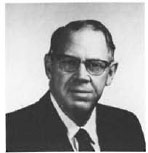- Volume 66 , Number 2
- Page: 241–4
Oliver W. Hasselblad, M.D. 1909-1997

Oliver W. Hasselblad, M.D., former president of American Leprosy Missions (ALM) and champion of people affected by Hansen's disease, was born in South Dakota, U.S.A., and died at the age of 88 on 3 May 1997 at his home in Redlands, California.
Before coming to American Leprosy Missions Dr. Hasselblad was a medical missionary in Assam, India, from 1938 to 1957 at the American Baptist Hospital in Jorhat. When Dr. and Mrs. Hasselblad took over the medical work at Jorhat in 1938 it was a small institution of 25 beds. When he left India in 1957 it was a large thriving community with a general hospital of 225 beds, including a tuberculosis hospital, a greatly enlarged leprosy settlement and two outlying medical units in the Naga hills. The expansion had been largely made possible by Dr. Hasselblad's own earnings as a physician to the large tea plantations in that area. During his time in India, Dr. Hasselblad was awarded the Kaisar-I-Hind distinction by the government of the day for his outstanding service. Dr. Hasselblad was appointed president of American Leprosy Missions in 1959. He quickly became a tireless advocate of integration and rehabilitation.
Basing his philosophy on the biblical concept of justice [Psalm 82:3], in many ways he was ahead of his time. When he came to ALM, the majority of patients were still treated in segregated institutions, and medical people believed that disability in leprosy was an inevitable concomitant of the disease and that rehabilitation of patients was not a practical possibility. Dr. Hasselblad's advocacy of integration of leprosy care into the basic health services and rehabilitation for people with disabilities due to leprosy often led him into conflict. He was always forthright and open in expounding his views. In many instances time proved him to be right. An editorial he wrote for this journal [Vol. 35, no. I, 1967] is typical. "We are not applying what we know," he wrote, and in the same editorial he deplored the failure to carry out "sufficient or authoritative scientific investigations of . . . many other problems having to do with social attitudes" toward leprosy. During his presidency ALM became heavily involved in training. It was he who initiated the ALM U.S. Public Health Service seminars at Carville, Louisiana, which began in 1960 and continued until the early 1990s. He made strenuous efforts to have leprosy recognized in the international rehabilitation arena, initially against great opposition because of the fear of leprosy as an infectious disease. He traveled widely for American Leprosy Missions making nearly 40 trips during the years 1958 to 1964 alone, and was widely used as a consultant by the Pan American Health Organization, the American Medical Association, USAID and the Christian Medical Commission. He was instrumental in the establishment of ALERT, was heavily involved in the development of the training centers at Karigiri, India, and Laura de Souza Lima in Brazil. It was also during his presidency that ALM accepted the responsibility for the business office of this journal.
Oliver Hasselblad was always on the lookout for young professionals who were interested in leprosy and became a mentor and an encourager to many, some of whom are still active in leprosy almost 25 years after he retired.
During most of his college years and also during his medical training. Dr. Hasselblad was pastor of a Baptist church in Omaha, Nebraska, and it was no doubt his pastor's heart which led him into missions and ultimately to leprosy.
In one of his last public statements as ALM president at the 1974 Leprosy Mission Centennial in London, Dr. Hasselblad had the following comments to make:
Commissioning those whom He (Jesus the Christ) had trained, one is reminded of basic principles used today in training and sending out paramedical workers; to reach into every village area of our responsibility, to heal the patient where he lives: 'Take nothing for the journey-neither stick nor pack neither bread nor money, nor are each to have a second coat.' Travel light! Keep it simple! In Christian leprosy work at its best, I have seen doctor, nurse, or paramedical worker moving out from the secure safe ground of an institution, using methods as simple as our Lord taught. And when this is consistently and systematically done, it is Christian leprosy work claiming our Lord's promises. What wonderful opportunities for such Christian workers to effectively 'proclaim the Kingdom of God' in the intimate surroundings of the patient's home and community, and to secure the assistance of Christian leaders and pastors in the area to build bridges of love and helpfulness to the patient.
Following his retirement from American Leprosy Missions in 1974, he continued working, first in the National Health Service in Jamaica and later on the island of Molokai in Hawaii.
He is survived by his wife, Norma; by his son, Carl, who is serving in Cambodia with USAID's Maternal and Child Health program; by daughters Marva Harle, at the Presbyterian Mission Hospital in Tshikaji in the Democratic Republic of Congo, and Wyva Hasselblad, with the Christian Reformed World Relief Committee in Senegal; and by six grandchildren.
- W. Felton Ross, M.B.B.S.